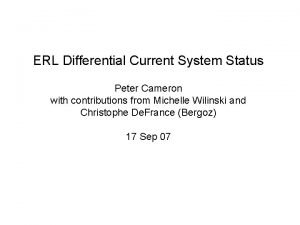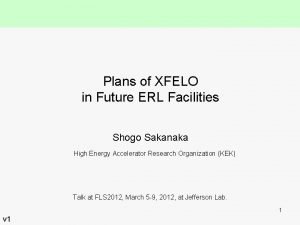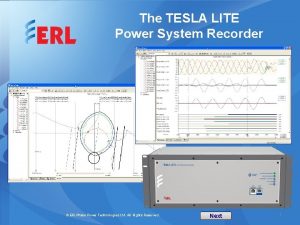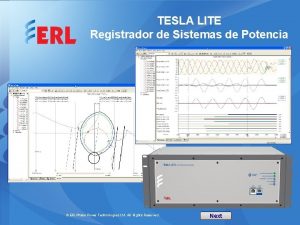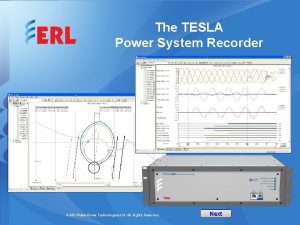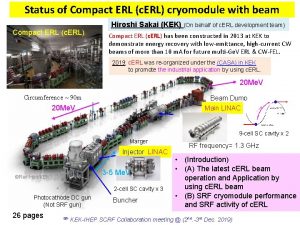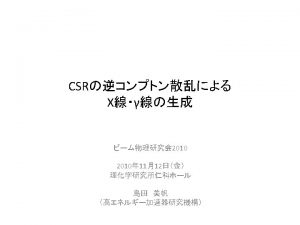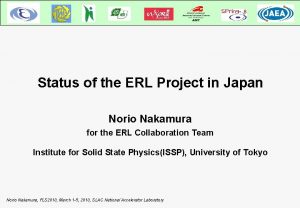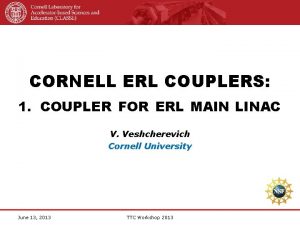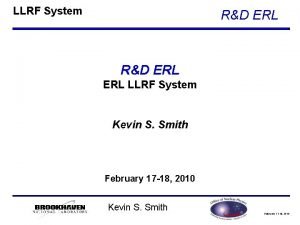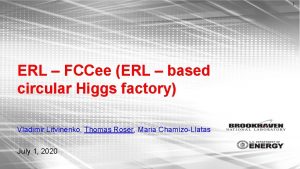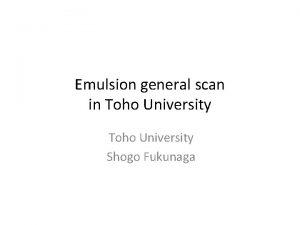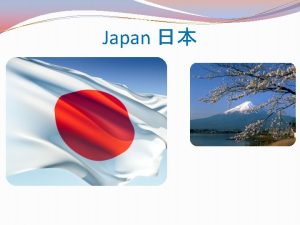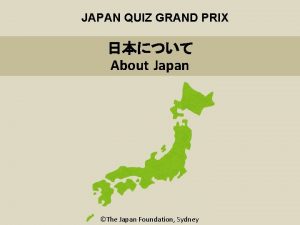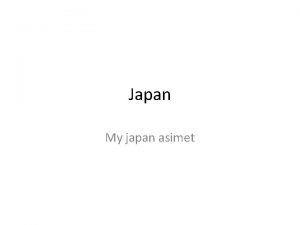Status of the ERL Project in Japan Shogo


































- Slides: 34

Status of the ERL Project in Japan Shogo Sakanaka for the ERL development team High Energy Accelerator Research Organization (KEK) Presentation at FLS 2012, March 5 -9, 2012, at Jefferson Lab. 1 v 1

Acknowledgment to Staff and Collaborators High Energy Accelerator Research Organization (KEK) M. Akemoto, T. Aoto, D. Arakawa, S. Asaoka, K. Endo, A. Enomoto, S. Fukuda, K. Furukawa, T. Furuya, K. Haga, K. Harada, T. Honda, Y. Honda, T. Honma, K. Hosoyama, M. Isawa, E. Kako, T. Kasuga, H. Katagiri, H. Kawata, Y. Kobayashi, Y. Kojima, T. Matsumoto, H. Matsumura, S. Michizono, T. Mitsuhashi, T. Miura, T. Miyajima, H. Miyauchi, N. Nakamura, S. Nagahashi, H. Nakajima, E. Nakamura, K. Nakanishi, K. Nakao, T. Nogami, S. Noguchi, S. Nozawa, T. Obina, S. Ohsawa, T. Ozaki, C. Pak, H. Sakai, S. Sakanaka, H. Sasaki, S. Sasaki, Y. Sato, K. Satoh, M. Satoh, T. Shidara, K. Shinoe, M. Shimada, T. Shioya, T. Shishido, T. Takahashi, R. Takai, T. Takenaka, Y. Tanimoto, M. Tobiyama, K. Tsuchiya, T. Uchiyama, A. Ueda, K. Umemori, K. Watanabe, M. Yamamoto, Y. Yamamoto, S. Yamamoto, Y. Yano, M. Yoshida Japan Atomic Energy Agency (JAEA) R. Hajima, R. Nagai, N. Nishimori, M. Sawamura, T. Shizuma Institute for Solid State Physics (ISSP), University of Tokyo I. Ito, H. Kudoh, T. Shibuya, H. Takaki UVSOR, Institute for Molecular Science M. Katoh, M. Adachi Hiroshima University M. Kuriki, H. Iijima, S. Matsuba Nagoya University Y. Takeda, Xiuguang Jin, T. Nakanishi, M. Kuwahara, T. Ujihara, M. Okumi National Institute of Advanced Industrial Science and Technology (AIST) D. Yoshitomi, K. Torizuka JASRI/SPring-8 H. Hanaki Yamaguchi University H. Kurisu 2

Outline 1. Outline of the ERL plan in Japan 2. Design of the Compact ERL (c. ERL) 3. Status of R&D and Construction 4. Summary 3

1. Outline of the ERL plan in Japan 4

KEK Photon Factory (at present) PF ring (2. 5 Ge. V) • • • E = 2. 5 Ge. V, C = 187 m Beam emittance : 34. 6 nm rad Top-up operation, I 0 = 450 m. A 10 insertion devices – In-vacuum X-ray undulators: 3 – VUV/SX undulators: 5 22 beamlines, 60 experimental stations Since 1982 PF-AR (6. 5 Ge. V) • • • E = 6. 5 Ge. V (injection: 3 Ge. V), C = 377 m, (I 0)max=60 m. A Beam emittance: 293 nm·rad Single bunch operation (full time) 8 beamlines, 10 experimental stations – In-vacuum X-ray undulators: 5 – Multi-pole wiggler : 1 5 Since 1987

3 Ge. V ERL Light Source Plan at KEK Needs for future light source at KEK l l Driving cutting-edge science Succeeding research at the Photon Factory (2. 5 Ge. V and 6. 5 Ge. V rings) 3 -Ge. V ERL that is upgradable to an XFEL oscillator Layout and beam optics are under design. lrf/2 path-length changer 3 Ge. V ERL 6 (7) Ge. V XFEL-O in 2 nd stage in the first stage 6

Tentative Layout of 3 -Ge. V ERL at KEK Beam energy Full energy: 3 Ge. V Injection and dump : 10 Me. V Geometry From the injection merger to the dump line : ~ 2000 m Linac length : 470 m Straight sections for ID’s 22 x 6 m short straight 6 x 30 m long straight Courtesy: N. Nakamura, M. Shimada, Y. Kobayashi Overall beam optics (merger → dump) Acceleration Deceleration 7

Beam Optics in 3 -Ge. V Linac Courtesy: N. Nakamura, M. Shimada, Y. Kobayashi triplet Cavities Eight 9 -cell cavities in a cryomodule. 28 cryomodules (252 cavities). Field gradient: 13. 4 MV/m Layout Focusing by triplets. Gradient averaged over the linac is 6. 4 MV/m Optics Minimization of beta functions to suppress the HOM BBU (optimized with SAD code) Body and edge focusing effects of the cavities are included with elegant code 8 8 Deceleration is symmetric to the acceleration.

Target Parameters for Typical Operational Modes High-brilliance light source High coherence High flux (HF) (HC) mode Beam energy XFEL-O Ultimate mode (future goal) 3 Ge. V XFEL-O 7 (6) Ge. V 1) Beam current 10 m. A 100 m. A 20 m. A Charge/bunch 7. 7 p. C 77 p. C 20 p. C Bunch repetition rate 1. 3 GHz 1 MHz Normalized beam emittance (in x and y) 0. 1 mm·mrad 0. 2 mm·mrad Beam energy spread (rms) 2 10 -4 2 ps 1 ps Bunch length (rms) 1) Parameters were estimated at 7 Ge. V. We are interested in 6 -Ge. V operation. 9

Spectral Brightness (high-coherence mode) Courtesy: K. Tsuchiya VUV-SX undulator X-ray undulator 10

Spectral Brightness (ultimate mode) Courtesy: K. Tsuchiya VUV-SX undulator X-ray undulator 11

(cf. ) Assumed Parameters of Undulators Courtesy: K. Tsuchiya VUV-SX undulator X-ray undulator Parameter Length of period lu Number of periods Nu 60 mm 83 (Lu = 5 m) 500 (Lu = 30 m) Parameter Length of period lu Number of periods Nu 18 mm 277 (Lu = 5 m) 1666 (Lu = 30 m) Maximum K-value Kmax 3. 5 Maximum K-value Kmax 2 Maximum magnetic field Bmax 0. 525 T Maximum magnetic field Bmax 1. 19 T Optical functions at undulator bx = by = 10 m ax = ay = 0 h = h’ = 0 12

Target: spectral brightness Targets for ERL XFEL-O ERL Figures are cited from: R. Hettel, “Performance Metrics of Future Light 13 Sources”, FLS 2010, SLAC, March 1, 2010. 13

2. Design of the Compact ERL (c. ERL) 14

The Compact ERL for demonstrating our ERL technologies Goals of the compact ERL l l Demonstrating reliable operations of our R&D products (guns, SC-cavities, . . . ) Demonstrating the generation and recirculation of ultra-low emittance beams ERL development building Parameters of the Compact ERL 70 m Parameters Beam energy (upgradability) 35 Me. V 125 Me. V (single loop) 245 Me. V (double loops) Injection energy 5 Me. V Average current 10 m. A (100 m. A in future) Acc. gradient (main linac) Normalized emittance 15 MV/m 0. 1 mm·mrad (7. 7 p. C) 1 mm·mrad (77 p. C) Bunch length (rms) 1 - 3 ps (usual) ~ 100 fs (with B. C. ) RF frequency 1. 3 GHz 15

Layout of the Compact ERL (single-loop version) 16

Optimized Design of Injector (for commissioning) Courtesy: T. Miyajima Point C 0. 69 mm mrad After optimization 0. 26 mm mrad Buncher Point A Diagnostic beamline for Injector Merger 500 k. V DC gun Injector Cryomodule Design layout of c. ERL injector. Example of parameters. After optimization Example of beam envelopes from the gun to a matching point. (T. Miyajima, presentation at ERL 11) Parameter Value Gun DC voltage 500 k. V Beam energy of injector 5 Me. V Charge/bunch 7. 7 p. C Full width of laser pulse 16 ps Spot diameter of laser Magnetic fields of solenoids #1, #2 Voltage of buncher cavity Eacc of 1 st, 2 nd, and 3 rd SC cavity Offset phase of 1 st, 2 nd, and 3 rd cavity 0. 38 mm 0. 0326, 0. 0318 T 90. 6 k. V 6. 46, 7. 52, 6. 84 MV/m 13. 6, 4. 8, 10. 017 degrees

Lattice and Optics Design of c. ERL Beam dump Injector SCC cryomodule Main SCC cryomodule Arc #1 (TBA) Three-dipole merger Bump magnets The Compact ERL 35 Me. V, 10 m. A version Courtesy: M. Shimada and N. Nakamura Bump magnets Photocathode DC gun Diagnostic beamline for Injection energy: 5 Me. V Arc #2 (TBA) Chicane for orbit-length adjustment Aperture: 35 mm in arc Energy acceptance: 2% Betatron functions in the return loop. Dispersion functions in the return loop. 18

Design of Radiation Shield Courtesy: K. Haga Roof: 1 -m thick Side wall: 1. 5 -m thick Japan is an earthquake-prone area. This shield can withstand both horizontal and vertical accelerations (earthquake) of up to 0. 5 G. 19

3. Status of R&D and Construction 20

Development of Photocathode DC Gun #1 at JAEA Courtesy: N. Nishimori HV processing of JAEA-gun with electrode in place Ø HV processing up to 526 k. V Ø Local radiation problem needs to be solved HV(k. V) 600 High voltage 400 200 0 0 4 time(hrs. ) HV(k. V) 600 526 k. V 400 200 0 112 N. Nishimori et al. , Presentation at ERL 2011. 8 116 time(hrs. ) 120 21

Development of Photocathode DC Gun #2 at KEK Aiming at Achieving Extreme High Vacuum Courtesy: M. Yamamoto • High voltage insulator – Inner diameter of f=360 mm – Segmented structure • Low outgassing material – Large titanium vacuum chamber (ID~f 630 mm) – Titanium electrode, guard rings • Main vacuum pump system e- beam – Bakeable cryopump – NEG pump (> 1 x 104 L/s, for hydrogen) • Large rough pumping system – 1000 L/s TMP & ICF 253 Gate valve Goal Ultimate pressure : 1 x 10 -10 Pa (during the gun operation)22 IPAC 2011 Spain Anode (0 V) Cathode (-500 k. V) 22 6 th, Sept, 2011

Superconducting Cavities for Injector Courtesy: E. Kako, K. Watanabe All of five HOM couplers are loop-type High-pass filter Prototype 2 -cell cavity #2 2 -cell cavities for cryomodule Fabricated input couplers New HOM-coupler design 23 Cryomodule design (3 D view)

Recent Vertical Test of the Injector Cavities Courtesy: E. Kako K. Watanabe Improved cooling in HOM couplers resulted in higher sustainable field-gradient. l We could keep high field-gradient of more than 20 MV/m (for cavities #3 and #5) for long time even when the HOM couplers were out of liquid Helium. 1) He <2 K Improved feedthrough for HOM couplers 1) These Q 0 -Eacc curves were measured when whole cavities were located in the liquid Helium. However, even when the upper HOM couplers were out of liquid Helium of 2 K, we could maintain high field-gradient of 30 MV/m (cavities #3 and #5). 24

Superconducting Cavities for the Main Linac Courtesy: K. Umemori HOM absorber Input couplers 9 -cell Cavities HOM Absorber Assembly of two 9 -cell cavities Cryomodule design Input coupler Cryomodule design (side view) 25

Vertical Test Results (of cavities #3 & #4 for the c. ERL cryomodule) • Eacc of higher than 25 MV/m could be achieved in both cavities. • Q 0 > 1010 at 15 MV/m • Satisfied c. ERL specification • Onsets of X-ray were 14 MV/m and 22 MV/m for the cavities #3 and #4, respectively. Q 0 Courtesy: K. Umemori #3 Q 0 vs Eacc Q 0 Eacc (MV/m) #4 Q 0 vs Eacc • Cavities are waiting for Heliumjacket welding and will be installed into cryomodule. Eacc (MV/m) 26

RF System for the c. ERL 9 -cell Cavity Injector Main Linac 300 k. W Klystron 30 k. W IOT Courtesy: T. Miura 30 k. W klystron 20 k. W IOT Gun Buncher Dump Two 9 -cell Cavities 2 -cell Cavities Double input couplers/cavity Parameters of RF System for the c. ERL (35 Me. V, 10 m. A version) Item Structure Gradient QL Beam Phase Power Required Power Output RF Source Power Available Unit MV degree k. W Buncher NC 0. 14 90 4. 5 6. 2 IOT 20 Inj-1 SC 1 5 105 15 to 30 10 17 Klystron 30 Inj-2 SC 2 2 105 10 37 Inj-3 SC 2 2 105 10 37 122 Klystron 300 ML-1 SC 15 2 107 0 11 ML-2 SC 15 2 107 0 11 30 IOT 30 27 27

1. 3 GHz CW RF Sources at KEK 300 k. W CW Klystron 30 k. W CW IOT Courtesy: T. Miura 30 k. W CW Klystron 20 k. W CW IOT -> to be delivered at the end of FY 2011 28 28

Beam Instrumentations for c. ERL Courtesy: Y. Honda, T. Obina, R. Takai Stripline BPM with glass-type feedthrough Screen monitor Slit for emittance measurement Two beam is running here: 2. 6 GHz rep rate 29

Liquid-Helium Refrigerator for c. ERL Courtesy: H. Nakai Overview of the system 2 K cold box Gas bag Purifier End box Liquefier/ refrigerator Pumping unit 2 K cold box Cooling capacity: 600 W (at 4 K) or 250 L/h 3000 L liquefied helium storage vessel 2 K cold box and end box 30 TCF 200 helium liquefier/refrigerator

ERL Development Building for c. ERL 31

Application of c. ERL: Plan of Laser Compton Scattering Experiment by JAEA 3 -year R&D program was funded from MEXT (2011 -2013) Nondestructive measurement of isotopes by LCS g-rays, which is applicable to nuclear security and safeguards purposes. ØInstallation of a LCS chamber ØGeneration of LCS gamma-rays ØDemo-Experiment of NRF measurement (NRF: Nuclear Resonance Fluorescence) Courtesy: R. Hajima electron gun superconducting accelerator LCS gamma-rays LCS chamber ØElectron beam = 35 Me. V, 10 m. A ØLCS photon flux = 5 x 1011 ph/s @22 ke. V possible upgrade in future ØElectron beam = 245 Me. V, 10 m. A 32 ØLCS photon flux = 1 x 1013 ph/s @1. 1 Me. V 32

Road Map of ERL Courtesy: H. Kawata Japanese Fiscal Year (from April to March) 2008 2009 2010 2011 2012 2013 2014 2015 2016 2017 2018 2019 2020 R&D of ERL key elements Prep of ERL Test Facility c. ERL Beam test and test experiments construction Improvements towards 3 Ge. V class ERL Construction of 3 Ge. V ERL Present time User run 33 33

4. Summary Future light source plan at KEK • 3 -Ge. V ERL with single return-loop • 6 -7 Ge. V XFEL-O is considered in the second stage R&D in progress • • High-brightness photocathode DC guns: 500 k. V, 10 m. A (100 m. A in future) Drive laser for the gun (520 nm, ~1. 5 W for c. ERL) SC cavities for both injector and main linacs RF sources (300 k. W CW klystron, etc. ) Compact ERL • • • First stage: 5 Me. V injector, 35 Me. V (single) return loop. 10 m. A. Upgradable: rooms for additional cryomodules and for double loops Liquid-helium refrigerator is working well. Construction of radiation shielding has been started. 34 We plan to commission c. ERL, hopefully, in March, 2013.
 Aaron garnett
Aaron garnett Erl diagram
Erl diagram Ge erl
Ge erl Tesla dfr
Tesla dfr Erlphase tesla 4000
Erlphase tesla 4000 Tesla 4000 dfr
Tesla 4000 dfr Erl logistics
Erl logistics Hát kết hợp bộ gõ cơ thể
Hát kết hợp bộ gõ cơ thể Frameset trong html5
Frameset trong html5 Bổ thể
Bổ thể Tỉ lệ cơ thể trẻ em
Tỉ lệ cơ thể trẻ em Chó sói
Chó sói Tư thế worm breton
Tư thế worm breton Hát lên người ơi
Hát lên người ơi Kể tên các môn thể thao
Kể tên các môn thể thao Thế nào là hệ số cao nhất
Thế nào là hệ số cao nhất Các châu lục và đại dương trên thế giới
Các châu lục và đại dương trên thế giới Cong thức tính động năng
Cong thức tính động năng Trời xanh đây là của chúng ta thể thơ
Trời xanh đây là của chúng ta thể thơ Mật thư tọa độ 5x5
Mật thư tọa độ 5x5 Làm thế nào để 102-1=99
Làm thế nào để 102-1=99 Phản ứng thế ankan
Phản ứng thế ankan Các châu lục và đại dương trên thế giới
Các châu lục và đại dương trên thế giới Thơ thất ngôn tứ tuyệt đường luật
Thơ thất ngôn tứ tuyệt đường luật Quá trình desamine hóa có thể tạo ra
Quá trình desamine hóa có thể tạo ra Một số thể thơ truyền thống
Một số thể thơ truyền thống Cái miệng nó xinh thế chỉ nói điều hay thôi
Cái miệng nó xinh thế chỉ nói điều hay thôi Vẽ hình chiếu vuông góc của vật thể sau
Vẽ hình chiếu vuông góc của vật thể sau Nguyên nhân của sự mỏi cơ sinh 8
Nguyên nhân của sự mỏi cơ sinh 8 đặc điểm cơ thể của người tối cổ
đặc điểm cơ thể của người tối cổ Thế nào là giọng cùng tên? *
Thế nào là giọng cùng tên? * Vẽ hình chiếu đứng bằng cạnh của vật thể
Vẽ hình chiếu đứng bằng cạnh của vật thể Phối cảnh
Phối cảnh Thẻ vin
Thẻ vin đại từ thay thế
đại từ thay thế

